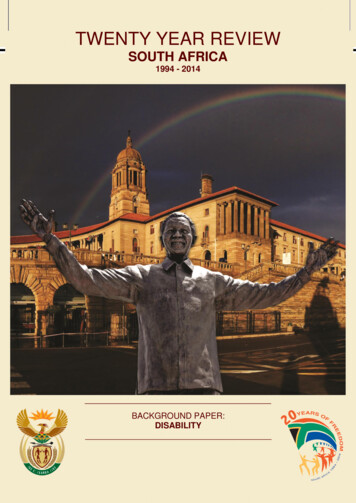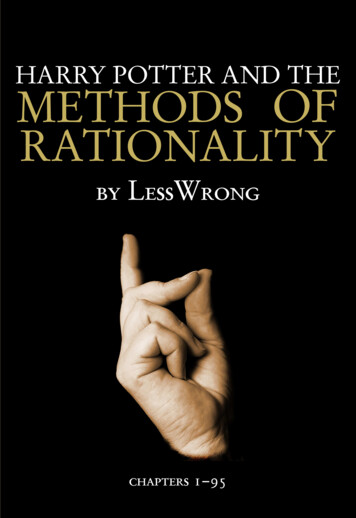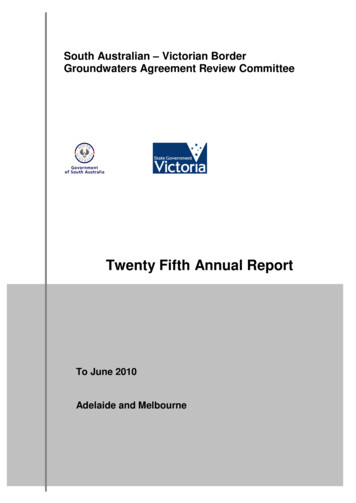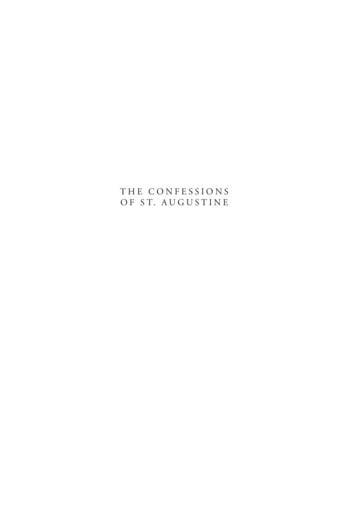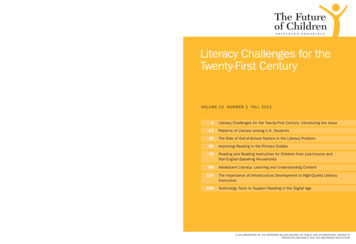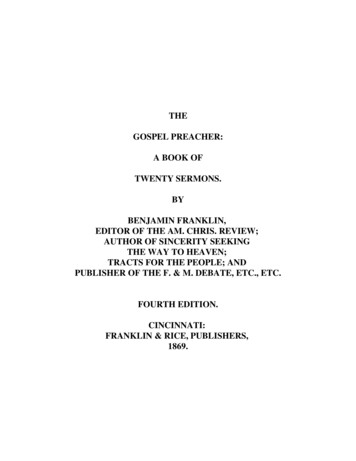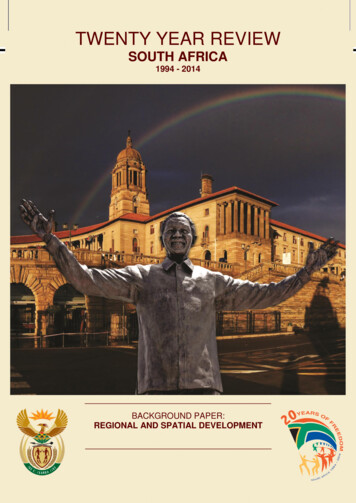
Transcription
TWENTY YEAR REVIEWSOUTH AFRICA1994 - 2014BACKGROUND PAPER:REGIONAL AND SPATIAL DEVELOPMENT
BACKGROUND PAPER: REGIONAL AND SPATIAL DEVELOPMENTContact details:Chantelle Van Der BylTel: (012) 312 0102Email: Chantelle@presidency-dpme.gov.zaDisclaimerThis background paper was written by Professor Philip Harrison (NationalPlanning Commission), drawing on literature reviews and background researchundertaken as part of the National Development Plan and related materials. Theviews reflected in the background papers do not represent those of thePresidency, rather the authors’ views on sector developments.2
BACKGROUND PAPER: REGIONAL AND SPATIAL DEVELOPMENTContentsAcronyms and Abbreviations . 2Policy Summary . 3Executive Summary . 4Review . 91.Introduction and background . 91.1Conceptual framework and purpose of the review . 91.1.1 Space matters. 91.1.2 Content of the review . 102. The journey since 1994 . 112.1Historical endowment in 1994 . 112.2Dynamics of the transition . 132.2.1 Institutional and policy changes. 132.2.2 South Africa and the world . 142.2.3 Spatial shifts by province . 172.2.4 Spatial shifts within South Africa’s settlement web . 222.2.5 Intra-urban change . 393. Reflection on achievements . 564. Towards improvement . 575. Summary and recommendations . 59References . 611
BACKGROUND PAPER: REGIONAL AND SPATIAL DEVELOPMENTAcronyms and NSADCSAPOASDFStatsTODUDFURPBus rapid transitCentral business districtCouncil for Scientific and Industrial ResearchDepartment of Human SettlementsGauteng City RegionGreenhouse gasGeo Terra ImageGross value addedInformation and communication technologyIntegrated Development PlanIndustrial Development ZoneInclusionary Housing PolicyInner Thekweni Regeneration and Urban Management ProgrammeIntegrated Urban Development FrameworkJohannesburg Development AgencyNational Department of HousingNational Development PlanNeighbourhood Development Partnership GrantNational Spatial Development PerspectiveNational Urban Development FrameworkOrganisation for Economic Cooperation and DevelopmentPassenger Rail Agency of South AfricaRural Development FrameworkReconstruction and Development ProgrammeSouth African Cities NetworkSouthern African Development CommunitySouth African Property Owners AssociationSpatial Development FrameworkSA Statistics South AfricaTransit-oriented developmentUrban Development FrameworkUrban Renewal Programme2
BACKGROUND PAPER: REGIONAL AND SPATIAL DEVELOPMENTPolicy SummaryRemoval of spatial restrictions, rather than proactive responses by government orthe private sector was responsible for the increased alignment between people andjobs since 1994.New residential developments have not always supported the overall goal of a moreefficient, equitable and sustainable urban form, and the location of private sector andgovernment-led housing did not result in positive spatial outcomes.More needs to be done to ensure that all housing financed by government is welllocated in relation to jobs, that the importance of backyard shacks is recognised andthat incentives are provided to ensure that this accommodation is upgraded toacceptable standards. The current investment in public transport also has to beupscaled.As movement into South Africa’s inner core continues, big cities are densifying,bucking the global trends towards lower urban densities. Densities are increasing aspeople find formal and informal accommodation opportunities – through theoccupancy of inner-city buildings and backyard shacks, but also townhousedevelopments and state-provided housing.The economic growth in the inner core has a positive impact in more peripheralareas, in terms of the labour market at least. Because of outmigration,unemployment rates in the periphery are dropping, and fewer people are living in socalled poverty traps.There are many other positives: a growing proportion of the population lives in formalaccommodation, gender inequalities in access to jobs are declining across allregions of the country, new public transport systems are being developed, parts ofcities are desegregating, inner cities are being regenerated, and levels of servicedelivery are rising in urban areas.Into the future, government’s central task must be to further facilitate the alignmentbetween people, on the one hand, and jobs, livelihood opportunities and services onthe other. At the national scale, this will involve facilitating the movement of peopleto places where jobs are being created. The focus must be on improving theabsorptive capacity of the municipalities in the inner core, where jobs are beingcreated at scale.3
BACKGROUND PAPER: REGIONAL AND SPATIAL DEVELOPMENTExecutive SummaryThe way in which people and economic activity are distributed across space is ofimportance for the national economy, as well as for individuals, households and firmsof all sizes. Economies generally tend to work better when there is a concentration ofactivity, and when logistical systems are functional. Where households are locatedcloser to jobs and livelihoods, prospects for economic success are significantlyenhanced. Poor spatial organisation also has environmental costs and can increasethe vulnerability of certain groups.It is this understanding of the importance of spatial organisation that frames SouthAfrica’s spatial journey since 1994. This review focuses on three broad aspects ofspatial development over the last 20 years. Firstly, it provides an account of thecountry’s provinces and cities in a globalising world, with particular reference totransnational migration, corporate linkages and international benchmarking.Secondly, it discusses spatial changes that reveal some big trends, but are too largeto provide real insights into spatial changes at the provincial level since 1994 indifferent types of settlements. Thirdly, it gives a detailed narrative based on anunderstanding of South Africa’s space economy as a complex network of interlockingeconomies in a continuum from an urban core to a deep periphery. The discussionfinally moves towards a finer-scale analysis, reflecting on changes withinmunicipalities, especially in larger cities.The legacy inheritedIn 1994, South Africa had a network of metropolitan cities, secondary cities, largetowns and smaller service centres that were well connected by road and rail.However, this masked a perverse set of spatial patterns reinforcing extreme socialinequalities and uneven access to the economy, with around 43 percent of SouthAfricans living in densely populated, mainly rural homelands. The spatial patternreflected, in part, the extraordinary experiments of the apartheid rule over fivedecades, but also centuries of colonial rule.Intentions of the post-1994 governmentThe Reconstruction and Development Programme (RDP) gave explicit recognition tospatial inequities, calling for a coherent approach to urban and rural development,which led to the development and publication of urban and rural developmentframeworks in 1997. However, these frameworks had to be translated into policies,which proved to be a lengthy process.The journey since 1994Institutional and policy changesDespite the introduction of significant reforms to the structure of provinces and thesystem of local government, the building of a capable and developmental state is anunfinished job.4
BACKGROUND PAPER: REGIONAL AND SPATIAL DEVELOPMENTSouth Africa and the worldThe ending of apartheid reopened South Africa to the world, but the provinces, townsand cities did not connect evenly, with particular provinces and cities emerging asgateways to the global community. Gauteng is a gateway for transnational migrants,while the Western Cape is a secondary node, with a specific concentration on nonSADC (Southern African Development Community) migrants. SADC migrants areconcentrated in North West, Limpopo and Mpumalanga.Based on the Global Connectivity Index, a study that focuses on the extent to whichcities are host to advanced producer services, the only African city in the top 50 isJohannesburg, with a global ranking of 44th. This position is partly a result of itsemergent role as a financial services gateway. Based on the Globalising CitiesIndex, which incorporates the Global Connectivity Index, as well as measures towhich cities perform “command and control” functions in the global economy, theonly African city in the top 100 is Johannesburg, in position 61.Spatial shifts by provinceCensus information of Statistics South Africa (Stats SA) reveals a large swing inpopulation towards Gauteng, a move towards the Western Cape and relativedeclines in the Eastern Cape, the Northern Cape, the Free State, KwaZulu-Natal andLimpopo. Furthermore, there are some income differentials between provinces.There is also a gradual equalisation, as well as a varying and complex pattern ofunemployment, with modest declines in most provinces, but an increase in theWestern Cape and Free State. The information also indicates higher levels of femaleunemployment across all provinces, but a closing gap between male and femaleunemployment. This is due to the fact that job creation for females is rising fasterthan that for males.Spatial shifts within South Africa’s settlement webA simple differentiation between urban and rural, and even between differentsettlement categories, is inadequate to capture the variation between places in termsof economic performance, job creation and population growth. A classification ofinner core, outer core, semi-periphery, periphery and deep periphery is used for thepurposes of this analysis.South Africa’s inner core has a complex structure, but one that is dominated by onlythree urban agglomerations. The largest is the agglomeration centred around theGauteng City Region, which accounts for nearly half of the population and over halfof the gross value added (GVA) of the inner core. The other two are centred aroundCape Town and eThekwini. Together, these three agglomerations account for 83percent of the population of the inner core and 86 percent of GVA. All the otherregions (Nelson Mandela Bay, Mangaung, Buffalo City, the Free State Goldfields,Polokwane, Mbombela, the Kimberley Diamond Fields and the Tourism Belt of theCape South Coast) collectively account for the remaining 17 percent of the5
BACKGROUND PAPER: REGIONAL AND SPATIAL DEVELOPMENTpopulation and 14 percent of GVA. It is clear that South Africa is highly dependent ona small number of places for its economic wellbeing.The outer core also has a fairly complex structure, although it is far less significant ineconomic terms than the inner core. Economic growth in aggregate, and in mostareas, is less than the national average, and so the outer core has lost position inrelative terms. There is, however, a cluster of relatively high growth areas, such asthe N1 corridor from Gauteng to Zimbabwe. The belt of small towns in the WesternCape around the metropolitan agglomeration is also experiencing higher-thanaverage growth. The towns along the N3 between eThekwini and Gauteng(Newcastle, Ladysmith and Harrismith) are generally not performing as well as thoseon the N1 corridor. The more scattered towns, off the major corridors, are alsoexperiencing slow rates of growth; on average, less than 2 percent per annum. Thedensely populated former Bantustan areas are, with the exception of those inLimpopo, experiencing the lowest rates of economic growth.The periphery is a category of municipalities with slow overall economic growth(1.63 percent per annum) and very slow population increase (0.69 percent perannum). The variation between municipalities in this category is relatively small, withalmost all local economies struggling in the face of a depressed agricultural sectorand the effect of outmigration in the service sector.The marginal economies in the deep periphery are growing at approximately1.9 percent, with a population change of just 0.64 percent per annum. These areareas of low population where natural population increase is only just compensatingfor outmigration.Although the space economy of South Africa is complex, the overwhelming picture isthat of a high and increasing level of economic concentration in a few localities. It isonly within the inner core of South Africa that there is a relative gain in economicoutput, and even within this core, economic output is becoming more concentratedwithin the three dominating metropolitan agglomerations. There are, however,scattered localities in more peripheral areas where GVA is growing rapidly, althoughgenerally from a low base.The population distribution in South Africa has, historically, been more dispersedthan economic output, largely because of colonial and apartheid rule, which keptlarge numbers of people within the “reserves” or “homelands”. This is changing asindividuals and households are able to move into areas of greater economicopportunity. Again, the pattern is one of huge concentration in the large centres, withother areas of growth including the Platinum Belt and a few secondary cities.6
BACKGROUND PAPER: REGIONAL AND SPATIAL DEVELOPMENTIntra-urban changeThe changes that happen in a municipality make the biggest impact on the daily livesof people, as it affects their ability to access jobs, livelihoods and services, andimpacts directly on household budgets. Some key dimensions are identified, ratherthan a comprehensive review of changes within settlements. Processes that areexplored include urban densification, socio-spatial integration, private sector-ledinvestment on the urban edge, partnership-led inner city rejuvenation, public housinginvestments, informal accommodation, transformation in historically black townships,and new systems of public transport. Despite significant transformation, apartheidspatial structures have shown more resilience than anticipated.Celebrating progress, confronting challengesThere is much to celebrate. Barriers to human movement have been removed, andpeople and jobs are coming together in an increasingly close alignment. Within theinner core, cities are producing the most jobs and are attracting the biggest increasein population. As South Africa’s big cities are densifying, people find formal andinformal accommodation opportunities. With outmigration from the periphery,unemployment rates in the periphery are dropping, and fewer people are living inpoverty traps.Additional positive changes include the growing proportion of the population in formalaccommodation, declines in gender inequality in access to jobs, new transportsystems, rising levels of serving in urban areas and so on.Confronting challengesMuch of the progress made was a result of the removal of spatial restrictions, ratherthan proactive responses by government or the private sector. Developments havenot always supported the overall goal of a more efficient, equitable and sustainableurban form, and the location of private sector- and government-led housing did notresult in positive spatial outcomes. There has been a degree of socio-spatialintegration, but the overall pattern of socio-spatial segregation is still largely intact.Better located townships have transformed to some degree, attracting large capitalexpenditure from government and the private sector in the retail sector, but the goalof integrating townships into the urban core remains elusive. More could also bedone at a national scale to align people and jobs. Environmental sustainabilityremains a concern across the country.Pointers to the futureInto the future, government’s central task must be to further facilitate the alignmentbetween people, on the one hand, and jobs, livelihood opportunities and services onthe other. At the national scale, this will involve facilitating the movement of peopleto places where jobs are being created. The focus must be on improving theabsorptive capacity of the municipalities in the inner core, where jobs are beingcreated at scale.7
BACKGROUND PAPER: REGIONAL AND SPATIAL DEVELOPMENTMore needs to be done to ensure that all housing financed by government is welllocated in relation to jobs, that the importance of backyard shacks is recognised andthat incentives are provided to ensure that this accommodation is upgraded toacceptable standards. The current investment in public transport also has to beupscaled and more attention should be given to the sustainability of investment andto integration between modes of transport across municipal boundaries. Criticalinterventions outside the inner core to support job creation may include transportinfrastructure to unlock mining potential and targeted support for the regeneration ofagriculture, giving special attention to areas where economic growth dynamism isevident.8
BACKGROUND PAPER: REGIONAL AND SPATIAL DEVELOPMENTReview1. Introduction and background1.1Conceptual framework and purpose of the review1.1.1 Space mattersThe ways in which people and economic activity are distributed across spacematters. It matters for the national economy, but also for individuals, households andfirms of all sizes. There is a close association between spatial patterns and thecapacity of an economy to grow and produce jobs. Economies generally work betterwhere there is a concentration of activity – where there is a large pool of labour, aconcentration of skills, a market for goods that are produced, and a dense network ofsocial and business relationships. The benefits of this concentration are referred toas “agglomeration economies”.The logistics of crossing space is important to firms – workers and managementmust get from their homes to their jobs each day, raw materials or supplies have tobe delivered on time, customers must access the firm, information must flow quicklythrough IT networks, and goods or services must be distributed to their appropriatedestinations. If the spatial functioning of a logistics system is inefficient, costs will behigh, and the performance – and even the viability – of the firm will be affected.There is also a strong relationship between spatial patterns and the welfare ofhouseholds. Where households are located near areas of job and livelihoodopportunities, their prospects for economic success are significantly enhanced. Ifplaces of work are separated from places of residence by a long distance, or by aninefficient transportation system, households may spend a disproportionate amountof time and money on travel, and poverty levels will be exacerbated. Spatialseparation also affects the ability of households to access services like schools,colleges, clinics, hospitals, childcare facilities, shops, government offices and placesof recreation.Furthermore, spatial arrangements have an impact on the way society works,especially on the way we relate to each other as individuals and as communities. Ifdifferent groups – defined by race, income, national origin or any other criteria – arespatially separated, a lack of understanding and knowledge of “the other” may breedintolerance, suspicion and fear, and society will be deprived of the liveliness andcreativity that comes from diversity.Poor spatial organisation has environmental costs. Where densities are low anddependence on the private car is excessive, air pollution and carbon emissions willbe high. Where residential areas are poorly located in relation to polluting industries,9
BACKGROUND PAPER: REGIONAL AND SPATIAL DEVELOPMENTthe health of residents will be affected, and where residential development occurs inareas of environmental risk, individual and social vulnerability increases.1.1.2 Content of the reviewIt is this understanding of the importance of spatial organisation that frames thenarrative of South Africa’s “spatial journey” since 1994. Before relating the journey, itis necessary to reflect briefly on the spatial legacies inherited in 1994. It is a complexand difficult legacy that has made the journey both extraordinarily challenging andabsolutely necessary.Relating the journey requires technical analysis. The latest available statistics areused in this report. Population data is taken from Census 2011, and economic datamainly from the IHS Global Insight. The authors also draw on earlier work on spatialchange undertaken by the Council for Scientific and Industrial Research (CSIR) andbackground research undertaken by the National Planning Commission in preparingthe National Development Plan (NDP).This review focuses on three broad aspects of spatial development over the last 20years. Firstly, it provides a brief account of South Africa’s provinces and cities withina globalising world, with specific reference to transnational migration, corporatelinkages and international benchmarking. Secondly, it discusses the history of spatialchanges by using the provinces as the unit of study. It reveals some of the bigtrends, such as the population shift to Gauteng and the Western Cape, and agradual process towards greater equity in incomes across space, but the scale is toolarge to give real insight into what has happened in different types of settlementssince 1994. Thirdly, it gives a more detailed narrative based on an understanding ofSouth Africa’s space economy as a complex network of interlocking economies in acontinuum from an urban core to a deep periphery. This approach, combined withthe use of recently released data, offers new insights into the intertwined processesof spatial development across South Africa.This is followed by a reflection on changes that have taken place withinmunicipalities, and especially within the larger cities where the greatest economicand population growth is concentrated. The extent to which transformation hasoccurred in urban areas since 1994 is investigated, and an exposition of thetransformation is provided. The authors also take a look at what has remained thesame or has failed to transform.This four-pronged approach is followed in reflecting on the achievements that havebeen made. This review attempts to provide an integrated account of the spaceeconomy, transcending socially defined categories such as “urban” and “rural”.However, in the detail of the analysis, the review focuses specifically on urban areas,as a separate review was commissioned on rural transformation (see separatechapter on Rural Transformation).10
BACKGROUND PAPER: REGIONAL AND SPATIAL DEVELOPMENT2. The journey since 19942.1Historical endowment in 1994South Africa entered the democratic era with a population of around 40 millionpeople, of whom 53 percent lived in urban areas. In some respects, South Africa wasnot very different from other middle-ranking countries globally. It had a moderneconomy with a network of metropolitan cities, secondary cities, large towns, andsmaller service centres, well connected by road and rail. This, however, masked aperverse set of spatial patterns that reinforced extreme social inequalities anduneven access to the economy.In 1994, around 43 percent of South Africa’s population lived in densely populated,mainly rural territories known as homelands. This severely distorted the commoninternational pattern of dense populations in and around the major urban centres andthinly populated farming areas. Within individual towns and cities, spatial patternswere also aberrant. Race groups were spatially segregated, with the poorest (mainlyblack) communities relegated to the urban edge, in localities furthest from jobs andurban services.The spatial pattern reflected, in part, the extraordinary experiments of the apartheidrule over five decades, but also centuries of colonial rule. Among the criticalproblems facing South Africa’s towns and cities by the 1990s were the following: Deeply entrenched patterns of racial segregationHighly fragmented urban areas with an inversion of the “natural” relationshipbetween density and distanceLow-density sprawl in the middle-class suburbs with decentralised economicactivity and inner-city declineA massive challenge for the daily movement of people, with transport costsexcessively high for poor households in international termsA process of land invasion and informal settlement formationPoorly developed and deteriorating public transport systems (although theprivately owned minibus taxi industry was proving to be highly successful)Cities of extreme inequality, with Gini coefficients among the highest in the worldVery low urban densities in relation to international benchmarks for efficient andvibrant urban formsInefficiency in the use of resources such as energy and waterIt is clear that the Government of National Unity, inaugurated in 1994, recognised thedamaging spatial legacies of apartheid with the founding policy of the newdemocracy, the Reconstruction and Development Programme (RDP), giving explicitrecognition to spatial inequities.11
BACKGROUND PAPER: REGIONAL AND SPATIAL DEVELOPMENTThe RDP called for a coherent approach to urban and rural development, and theRDP Office set up task teams to produce urban and rural development policy. In1997, the government published both a Rural Development Framework (RDF) andan Urban Development Framework (UDF).1 The UDF was a statement of positiveintention. It produced a vision of towns and cities that were spatially and socioeconomically integrated, economically competitive internationally, centres ofeconomic and social opportunity, centres of vibrant and democratic urbangovernance, environmentally sustainable, providing high-quality housing,infrastructure and services, and enabling easy access to a range of urbanopportunities (National Department of Housing, 1997). In order to realise this vision,specific goals were set that were to be “relentlessly pursued” (National Departmentof Housing, 1997): Create more efficient and productive cities and towns through the growth anddevelopment of local economies.Reduce disparities by providing infrastructure and facilities to disadvantagedcommunities.Provide access to better housing and shelter, and greater security of tenure forurban residents.Tackle spatial inefficiencies that give rise to long travelling distances and timesthat negatively impact on the accessibility of work and other opportunities, bypromoting urban densification in conjunction with more efficient publictransportation.Improve the overall quality of the urban environment by better integratingenvironmental concerns in development planning and urban management.Transform municipalities into effective and accountable institutions throughcapacity-building programmes that also promote the active interaction of civilsociety with municipalities.The intentions were positive and clear, but the UDF was a very broad statement ofprinciple and needed translation into a more detailed urban policy, which has provento be a lengthy process. In terms of spatial restructuring at a national scale, therewas significantly less clarity. It proved surprisingly difficult to produce a coherentspatial policy. Although there was broad consensus over the need to address thelegacies of apartheid, there was no agreement on how to achieve this. For example,should jobs be brought to the people, or should people be brought to the jobs?Should investment go to the former homelands or should the state encourage peopleto move away from the homelands?1The rural development review is discussed in a separate chapter, but suffice it to say here that morecould have been done at an early stage to create a framework for dealing with rural and urbandevelopment in more integrated ways. Within government, two separate policy tracks emerged,accompanied by a growing tension between a rural and an urban orientation.12
BACKGROUND PAPER: REGIONAL AND SPATIAL DEVELOPMENT2.2Dynamics of the transition2.2.1 Institutional and policy changesThere have been dramatic changes since 1994, which made it possible to address aspatial transformation agenda. Most important among these were the integration ofthe former Bantustans into the new provinces and the introduction of a new systemof local government. The new municipalities are allowing for wall-to-wall rural-urbanintegration in planning, while the single-tier, or “unicity model”, for metropolitan areasgreatly improved the chances of citywide coordination in planning, infrastructureprovision and service delivery. The big picture in terms of institutional change ispositive. Indeed, few countries have
The ending of apartheid reopened South Africa to the world, but the provinces, towns and cities did not connect evenly, with particular provinces and cities emerging as gateways to the global community. Gauteng is a gateway for transnational migrants, while the Western Cape is a secondary node, with a specific concentration on non-


